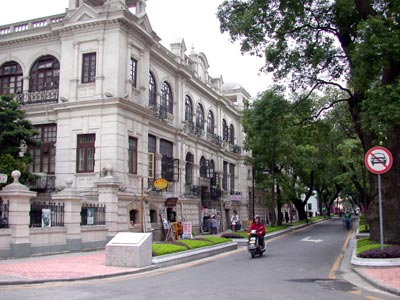
|
Historic sites of GuangzhouShamian Scenic Spot Located on the north bank of the Pearl River's White Goose Pool, Shamian is an oval islet, covering a tiny area of 0.3 square meters. Thanks to the many buildings of Western classicism on the island, it has recently been designated as a key protected relic of the state, and is called the 'Ninth Sight of Guangzhou'. Shamian used to be an alluvion made by the Pearl River, called Zhongliusha and Shicuizhou in the early stage. It had been a tourist attraction as well as an important port for Guangzhou's foreign trade from Song Dynasty (960–1279) to the Qing Dynasty (1644-1911). It became a strategic point for city defense during the opium war period, after which the Qing Administration was forced to agree to 'lease' Shamian to the British and French imperialist powers, thus Shamian was reduced to the British and French concessions and changed to the present name. When digging the waterway during 1859 to 1862, Shamian was separated from the north bank of the Pearl River and a stone bridge was built only in the east to connect the north bank. Now Shamian embraces eight major roads and streets, of which three are from east to west: Shamian North Street, Shamian Street and Shamian South Street, and five from south to north: Shamian No. 1 to 5 Streets. And in the east, north and west there are respectively East Bridge, West Bridge and New West Bridge to connect Liuersan Road. The island boasts many trees and pleasant environment, together with such buildings, organizations, sports and entertainment facilities as the Victory Hotel, Shamian Hotel, White Swan Hotel, Guangzhou International Seamen's Club, the Polish Consulate-General in Guangzhou, the Representation of the Export and Import Corporations of the Democratic People's Republic of Korea, Guangzhou Office of China-Poland Shipping Ltd., Shamian Tennis Court, Shamian Swimming Pool and so on. What is worth mentioning on Shamian is its restricted planning area, namely the area protected by the state as key historical relics, including the architectural complex built during the concession period in Shamian's modern times. The area became concession in 1859, and afterwards the British, French, American, German, Japanese, Italian, Netherlands and Portuguese set up consulates, banks and trade offices, one after another. The Kuomintang government took over Shamian after winning the Anti-Japanese War in 1945. Quite a few of the old buildings are of Western classic layout. Bus: 1, 5, 9, 25, 57, 64A, 69, 75, 81, 181, 206, 208, 222, 227, 233, 236, 250 |
|
| Site Map | RSS | Newsletter | Work for Us Copyright © China.org.cn. All Rights Reserved 京ICP证 040089号 |
 0
0 








Go to Forum >>0 Comments